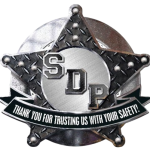Compact kubotans are ideal self-defense tools that you can easily fit in your palm or attach to a keychain. They're primarily made from durable materials like aluminum, ensuring both lightweight and sturdy construction. You can amplify your striking force using these tactical tools by targeting pressure points effectively, thanks to their textured grip for non-slip handling. You'll find kubotans offer a perfect blend of convenience and impact without appearing as conventional weapons, keeping you prepared and protected discreetly. Explore how to choose the best kubotan, opt for the right material, and master their use for maximum defense advantage.
Key Takeaways
- Compact kubotans are discreet self-defense tools, easily attachable to keychains for quick access.
- Made from materials like aluminum, they offer durability and lightweight convenience for personal protection.
- Their design allows for effective targeting of pressure points, amplifying the force of strikes in close-quarter situations.
- Legal status varies, so understanding local laws is crucial before carrying a kubotan.
- Regular practice and self-defense training enhance kubotan effectiveness and user confidence in real situations.
Understanding Kubotans
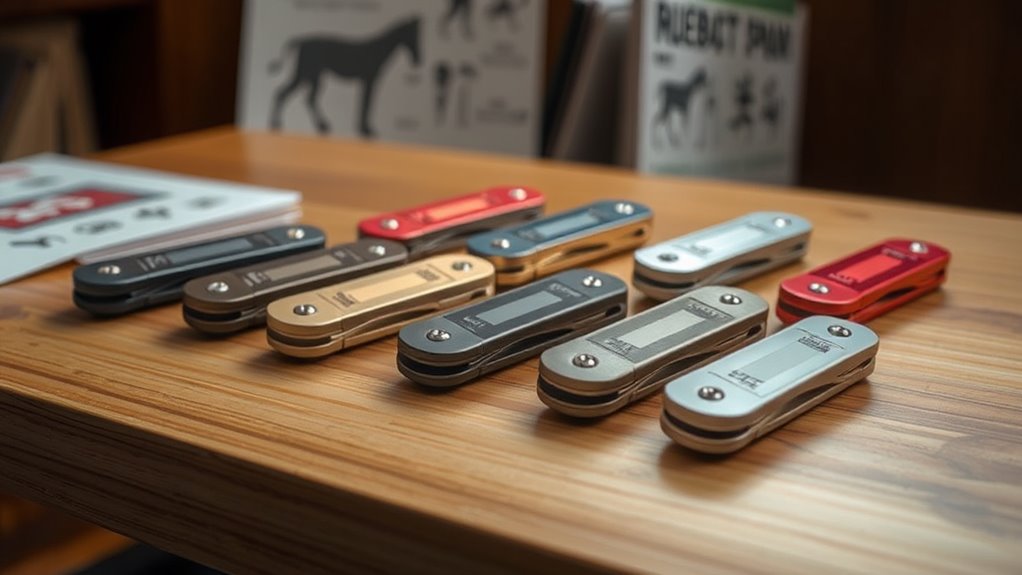
Although often underestimated, kubotans are powerful self-defense tools that can fit in the palm of your hand. When you're looking for a compact and effective way to enhance your personal safety, understanding the different kubotan types is vital.
These versatile tools come in various forms, each designed for specific needs. You might encounter basic keychain kubotans, which are convenient and discreet. They're perfect for attaching to your keys, keeping them within reach whenever necessary.
There are also tactical kubotans, often made from durable materials like aluminum or steel, offering a more robust option for those who might need extra impact. Some kubotans, like the Peace KEYper Self-Defense Tool, are specifically designed to convert everyday items into a means of protection.
The benefits of carrying a kubotan are plentiful. They're legal in many regions, making them accessible for those seeking non-lethal self-defense options.
Kubotans are easy to use, relying on simple techniques that don't require extensive training to be effective. You'll appreciate how they enhance your ability to deliver targeted strikes to pressure points, giving you a significant advantage in a confrontation.
Additionally, their compact size means they can be carried almost anywhere, ensuring you're always prepared to protect yourself. Embracing kubotans as part of your personal safety strategy can provide peace of mind and confidence. Made from aircraft grade aluminum, kubotans are designed to be both lightweight and exceptionally durable, ensuring long-lasting use.
History of Kubotans
Kubotans, often overlooked in the domain of self-defense tools, have an intriguing history that dates back several decades. Their origins trace back to the 1960s when Takayuki Kubota, a martial arts expert, introduced them as a keychain accessory.
Initially, they served as a personal safety tool, particularly for law enforcement officers in Japan. The cultural significance of Kubotans lies in their discreet design, which allows them to be carried easily without drawing attention, making them a staple in personal defense. Just like the firm rubberized grip of some self-defense tools, Kubotans are designed for secure handling.
As you explore the variations of Kubotans over the years, you'll notice an evolution in their design. Originally crafted from wood, modern Kubotans are now made from materials like aluminum and plastic, enhancing their durability and usability.
These changes reflect their adaptation to different usage scenarios, from simple self-defense to more complex martial arts techniques. The design evolution also means Kubotans are now available in various shapes and sizes, catering to different hand grips and preferences.
Understanding these nuances helps you appreciate the Kubotan's multifaceted role in self-defense, demonstrating its timeless relevance and adaptability to diverse situations. Embracing its history enriches your understanding of this compact yet powerful tool. Additionally, just like the compact design of stun guns, Kubotans offer a discreet yet effective option for personal safety.
Key Features
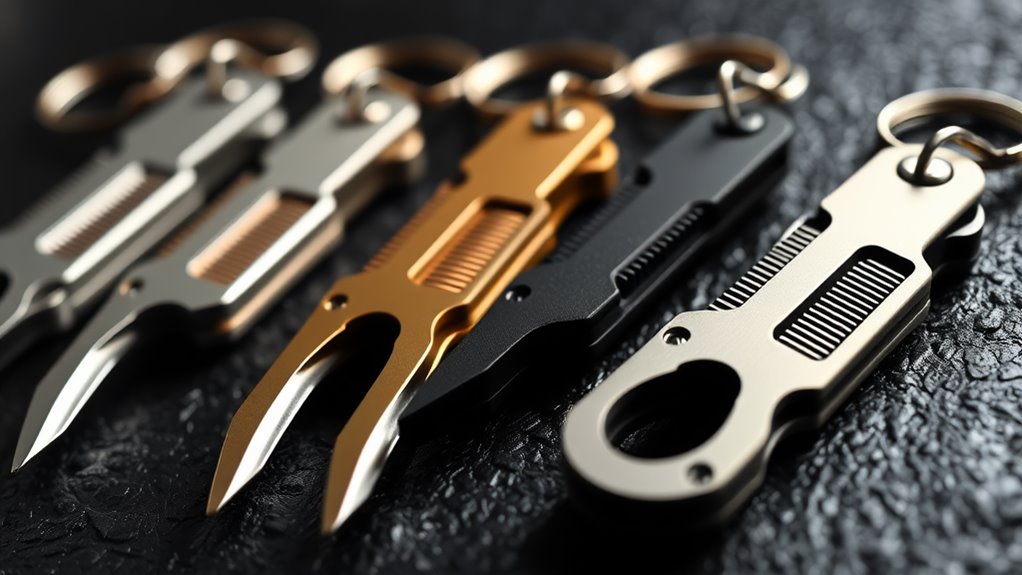
When it comes to the key features of Kubotans, there are several elements that make them indispensable in self-defense. First, their compact size means you can easily carry them wherever you go, making them a discreet yet powerful tool.
They're designed to fit seamlessly on your keychain, ensuring they're always within reach when needed. The self defense benefits are clear: a Kubotan can transform everyday situations into manageable scenarios by giving you a reliable means to protect yourself.
One of the primary practical applications of a Kubotan is its ability to amplify the force of your strikes. With its solid build and pointed end, you can target pressure points effectively, maximizing your defensive tactics.
It enables you to apply controlled force, turning your defensive reaction into an effective deterrent against potential threats. This feature is particularly advantageous in close-quarter situations where quick, decisive action is necessary.
Additionally, Kubotans often include a textured grip to prevent slipping, ensuring that you maintain control during a confrontation. This grip enhances your ability to execute techniques confidently. The Heart Attack Key Chain is another self-defense tool designed to fit conveniently on a keychain for quick access, ensuring you are always prepared.
Material Choices
Selecting the right material for your Kubotan can considerably impact its effectiveness and durability. When examining material choices, you'll want to focus on how they affect ergonomic designs and weight considerations.
Aluminum is a popular choice due to its lightweight nature and durability. It's easy to carry, and it won't weigh you down, making it an excellent choice for everyday use. Plus, its metallic finish provides a sleek look that complements ergonomic designs.
If you're seeking something more robust, consider stainless steel. Though heavier, it offers superior strength and longevity. The additional weight can enhance the impact force, but it might be less comfortable for prolonged carry. This is where ergonomic designs come into play—ensuring the Kubotan fits comfortably in your hand despite the extra heft.
Another option is high-impact plastic or polymer. These materials offer a good balance between weight and durability while often being more affordable. They're less likely to set off metal detectors, which can be a plus for frequent travelers.
However, they might lack the same impact strength as metal options. Ultimately, your choice should align with your specific needs, considering comfort, strength, and practicality.
How to Use
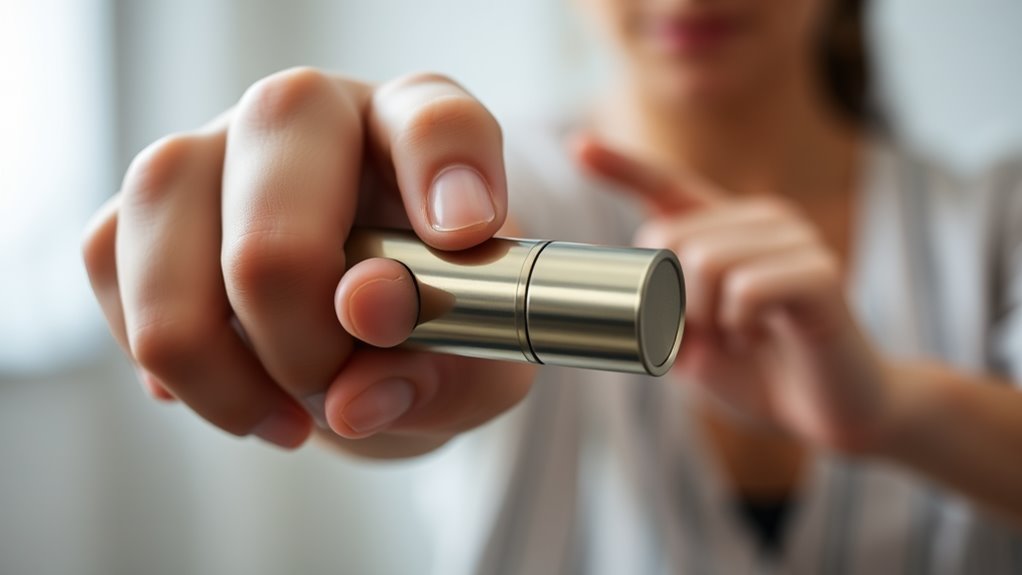
Mastering the use of a Kubotan can greatly enhance your personal security. To get started, make certain you have a firm kubotan grip. Hold it in your dominant hand, with the end extending slightly from your fist. This grip allows you to strike effectively and maintain control.
Your thumb should rest on top, providing stability, while your fingers wrap around it tightly. Practice this grip until it feels natural in your hand.
Once you're comfortable with the kubotan grip, familiarize yourself with pressure points on the human body. These are areas where a small amount of force can cause significant discomfort or immobilization.
Common pressure points include the solar plexus, located just below the ribcage, the throat, wrists, and the sides of the neck. Using a Kubotan to apply pressure to these areas can help you gain an advantage in a self-defense situation.
Self-Defense Techniques
Incorporating Kubotan self-defense techniques into your repertoire can greatly boost your confidence and ability to protect yourself. The Kubotan is a versatile tool that, when used correctly, can target pressure points and make a significant impact in self-defense situations. Understanding where these pressure points are located on the human body is vital. Areas like the solar plexus, wrist, and thigh are particularly sensitive and can be targeted effectively with sharp, precise strikes.
Mastering striking angles is key to maximizing the Kubotan's effectiveness. You should practice delivering strikes from multiple angles, such as downward, upward, and sideways, to adapt to various scenarios. This approach guarantees that you can respond quickly and strategically, even under pressure.
The compact design of the Kubotan allows you to maintain control and accuracy with each strike, which is essential for effective self-defense.
In addition to striking, you can use the Kubotan for joint locks and pressure holds, adding another layer of defense. By applying pressure with the Kubotan to joints and nerve clusters, you can immobilize an attacker momentarily, giving you precious time to escape or call for help.
Practice these techniques regularly to build muscle memory and confidence.
Legal Considerations
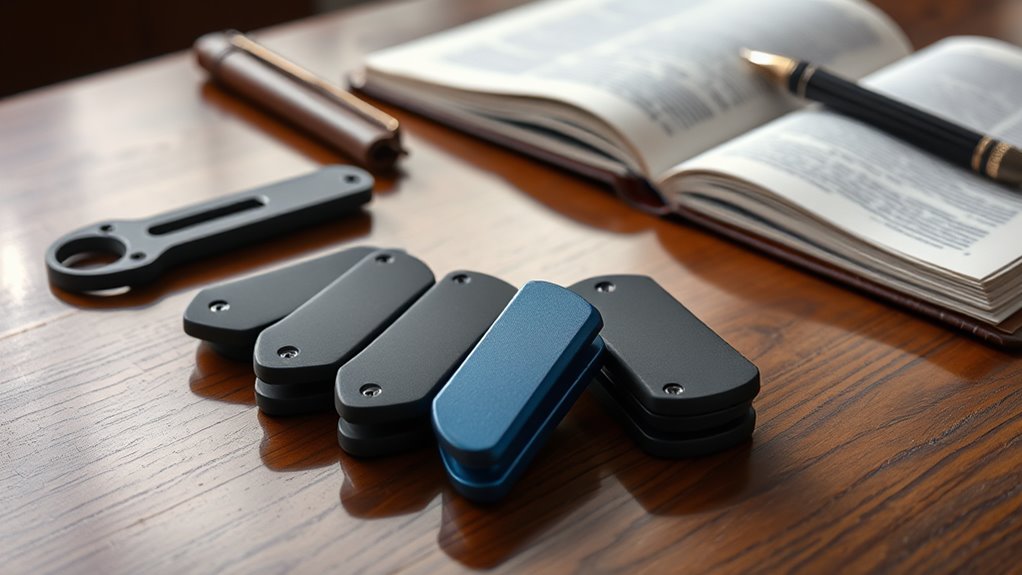
When considering Kubotans for self-defense, it's vital to understand the legal landscape surrounding their use. Legal restrictions can vary markedly depending on where you live, so you'll need to familiarize yourself with local self-defense laws. In some areas, Kubotans are classified as weapons, while in others, they're viewed as harmless keychain tools. Understanding these distinctions can save you from potential legal issues.
Start by checking state and local laws regarding Kubotans. Some jurisdictions might've specific regulations about carrying them openly or concealed. For instance, certain states categorize them under prohibited weapons, which could lead to fines or more severe penalties if you're caught with one illegally. It's important to know if you need a permit or if there are any specific conditions under which they're allowed.
Additionally, consider the broader context of self-defense laws. Even if Kubotans are legal in your area, using them in self-defense might still be scrutinized. Laws usually require that any force used in self-defense be reasonable and proportional to the threat faced.
Understanding these legal nuances guarantees you can protect yourself while staying compliant with the law.
Choosing the Right Kubotan
Understanding the legal considerations of carrying a Kubotan is just the first step; next, you'll want to focus on choosing the right one for your self-defense needs. The key to picking the perfect Kubotan lies in evaluating kubotan sizes and kubotan colors, guaranteeing it aligns with your personal style and comfort.
Start by considering kubotan sizes. A proper fit in your hand is essential for effective use. Compact sizes are ideal for discreet carry and quick access, while longer ones might offer more leverage. Try holding a few to determine which size feels most natural and comfortable in your grip.
Kubotan colors may seem like a minor detail, but they play a significant role. While black and metallic shades are common for their discreetness, bright colors can serve as a visual deterrent or make it easier to locate in a bag. Choose a color that suits your personal preference and assures quick recognition in an emergency.
Ultimately, the right Kubotan for you is one that balances size, color, and comfort. Take your time in selecting one that not only meets your aesthetic preferences but also feels like an extension of your own hand.
Training and Practice
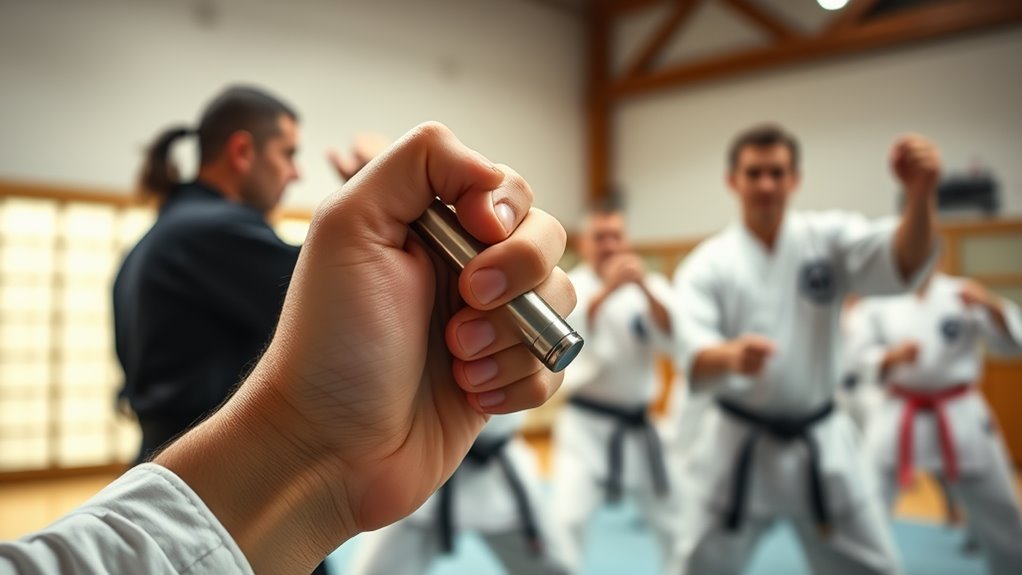
Before you can effectively wield a Kubotan for self-defense, proper training and regular practice are fundamental. Familiarize yourself with how to grip and maneuver it confidently. Attending self-defense classes that incorporate Kubotans will provide structured guidance. A trained instructor can introduce you to various training scenarios, helping you visualize real-life situations where a Kubotan might be necessary.
Training scenarios are vital because they simulate the stress and unpredictability of potential threats. You learn not only how to defend yourself but also how to maintain composure under pressure.
Practice drills, on the other hand, are about repetition and muscle memory. Set aside time to practice basic strikes, pressure point techniques, and defensive stances. These drills guarantee that your reactions become swift and automatic.
Practicing with a partner can be particularly beneficial. Engage in controlled sparring sessions to better understand timing and distance. It's about making your movements instinctive.
Maintenance Tips
While honing your skills with a Kubotan is essential, ensuring the tool itself is in top condition shouldn't be overlooked. Regular maintenance keeps your Kubotan effective and ready for use.
Start with the right cleaning techniques. Use a soft cloth dampened with mild soap and water to gently wipe down the surface, removing dirt and oils. Avoid harsh chemicals that might degrade the material. For metal Kubotans, a light application of oil can prevent rust, ensuring longevity.
After cleaning, dry your Kubotan thoroughly to avoid moisture damage. Pay special attention to any crevices, as trapped moisture can lead to corrosion over time.
Once clean, reflect on your storage solutions. Store your Kubotan in a dry, cool place, away from direct sunlight, which can weaken or fade certain materials. A designated drawer or a padded case can protect it from scratches and impacts.
Regularly inspect your Kubotan for any signs of wear or damage. If you notice any cracks or chips, it's time to think about a replacement.
With these simple maintenance tips, your Kubotan will remain a reliable tool in your self-defense arsenal. Keep it clean, store it properly, and you'll extend its lifespan considerably.
Frequently Asked Questions
Can Kubotans Be Customized With Personal Engravings or Designs?
You're wondering if you can customize them with personal engravings or designs. Absolutely, personalization options are available. Various engraving techniques allow you to add unique details, making it truly yours and reflecting your personal style and preferences.
Are Kubotans Suitable for Individuals With Limited Hand Mobility?
You might find kubotans challenging if you have limited hand mobility. However, exploring hand grip techniques and mobility adaptations can help. Adjustments can be made to guarantee a more comfortable and effective self-defense tool for you.
What Is the Typical Weight Range for Compact Kubotans?
You're wondering about the weight of these tools. Typically, they weigh between 1 to 2 ounces. Thanks to their compact design and various material options, you can find one that suits your preference and needs.
Do Kubotans Have Any Additional Uses Beyond Self-Defense?
Kubotans aren't just for self-defense techniques; you can use them for practical applications like breaking car windows in emergencies or as a keychain. They also serve as a tool for pressure point control in various situations.
Are There Any Kubotans Designed Specifically for Children or Teenagers?
Why shouldn't you consider child safety when choosing self-defense tools? Some kubotans are designed with younger users in mind, offering lightweight options. Teaching proper self-defense techniques guarantees they're both safe and effective for children and teenagers.



